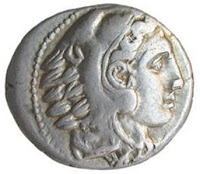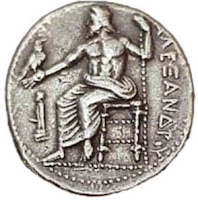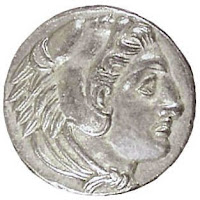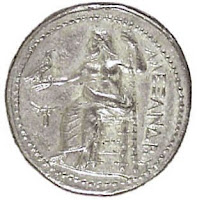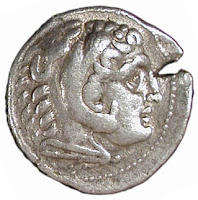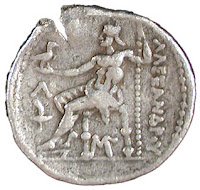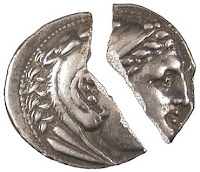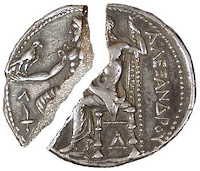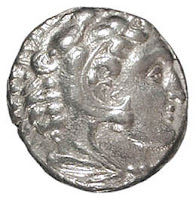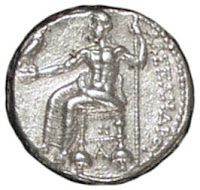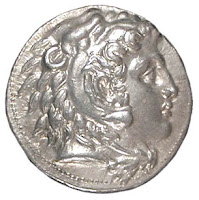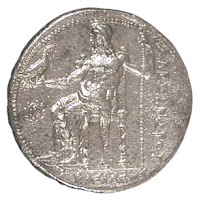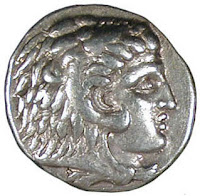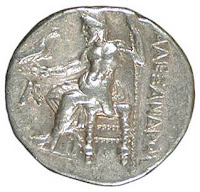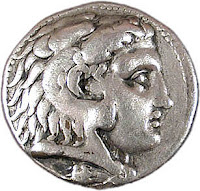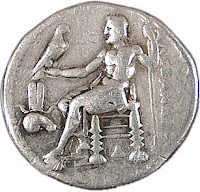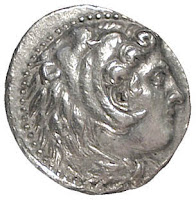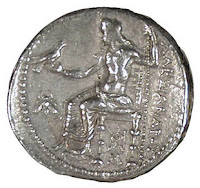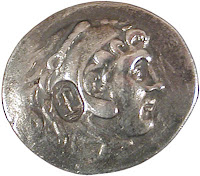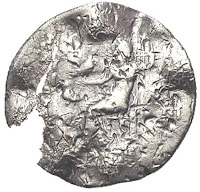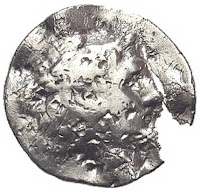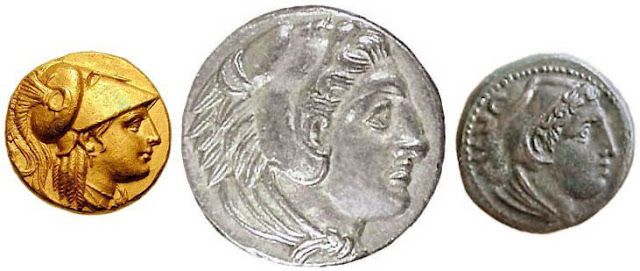 |
| Alexander the Great gold stater, silver tetradrachm, and bronze hemiobol |
Today, two rulers from ancient times stand out above all others: Alexander the Great and Julius Caesar. Alexander III was the greatest conqueror of all time. He never lost a battle, and at his premature death at about the age of 33 in 323 BC, he ruled over lands from Egypt to India.
These were powerful coins. They not only influenced the future of all subsequent coinage on three continents, they also depicted some powerful symbols, most notably Herakles (Hercules to the Romans), the ancient world's most powerful mythological hero, Zeus, king of the Olympian gods, Athena, the goddess who combined within her sphere both wisdom and warfare, and Nike, goddess of victory.
The following is a site on Alexander the Great coinage. Included are coins whose minting Alexander authorized during his lifetime, coins minted in his name and of his style after his death, and coins, medals, and tokens (and paper money) minted through the years depicting his portrait.
Alexander the Great lifetime tetradrachm from Amphipolis, Macedonia, c. 336-326 BC, 17.1g, M.J. Price 5, Newell Reattribution 5, Newell Demanhur 56-90, Müller 758, SNG Saraglos 185-186, SNG München 234, SNG Alpha Bank 469, SNG Milano 122, SNG Ash. 2526-2528, SNG Cop. 659, SNG Fitz. 2113, Le Rider Pl. 2 No. 5, Troxell A2, Seltman Pl. XLVIII No. 3. As with all of Alexander's imperial tetradrachms, the obverse of the above coin depicts a young (beardless) Herakles/Hercules wearing a lion skin headdress, with the lion's paws tied at his neck. The reverse of this coin depicts a bearded Zeus, naked from the waist up, with a himation (linen or woolen cloak) covering his lap and legs, sitting on a backless throne, holding an eagle in his right hand and a scepter in his left hand. Zeus' legs are open, or roughly parallel. The inscription translates into "Of Alexander."
The above coin was among the first imperial coins Alexander issued, at least in Macedon. Newell concluded that this variety was among a handful whose symbols also appeared on late coins of Philip II. The above and similar coins were likely issued by Alexander for recruiting his army in preparation for the invasion of the Persian Empire. This slightly off-center specimen emphasizes how ancient coins, unlike modern ones, were struck by hand, and frequently imperfectly. The mint mark in the reverse left field is a ship's stern, sometimes more accurately called an aplustre, which is an ornamental piece of wood attached to the stern of a galley.
Alexander the Great lifetime tetradrachm from Amphipolis, Macedonia, c. 325-323 BC, 17.2g, M.J. Price 78, Newell Reattribution 30, Newell Demanhur 716-791, SNG Saraglos 201, SNG München 257, SNG Delepierre 981-983, SNG Stockholm 271, SNG Ash. 2553-2557, SNG Cop. 676, Troxell E2, Dewing 1118, Waggoner Propontis 2, Wulfing 145, Hurter Fig. 2, Winterthur 1480, Pozzi 889-890. The mint mark in the reverse left field is a herm. Herms, which first appeared in the sixth century BC, were typically ithyphallic statues depicting a bearded head of Hermes. They were often used as boundary markers.
Alexander the Great lifetime tetradrachm from Amphipolis, Macedonia, c. 325-323 BC, 17.2g, M.J. Price 93, Newell Reattribution 33, Newell Demanhur 656-715, Müller 97, SNG Saraglos 208, SNG Alpha Bank 481, SNG Milano 128, SNG Hart 410, SNG Ash. 2570-2572, SNG Cop. 675, SNG Fitz. 2117, Visonà 2, Troxell E8, Dewing 1121, Newell Portrait Pl. I No. 13, Hunterian 50, Head Principal Pl. 30 No. 5. The mint mark in the reverse left field is a bucranium (ox head). A beaded border encircules the reverse.
Alexander the test-cut posthumous Great tetradrachm from Amphipolis, Macedonia, c. 315-294 BC, 16.7g, M.J. Price 447v., Müller 37v., SNG Saraglos 292v., SNG München 308v., SNG Milano 220v., SNG Hart 420v., SNG Tübingen 1094v., SNG Ash. 2630v.-2631v., Thompson Armenak 39v.-48v., Hunterian 44v. The above coin was cut with a chisel in ancient times to authenticate it, determining whether it was solid silver or only silver plated over a base metal interior.
This particular variety was part of a huge output of posthumous Alexander tetradrachms from Macedonia that feature as mint marks on the reverse a torch underneath the Greek letter lambda, with this variety also featuring a modified M monogram between the legs of the throne. On all the other specimens I've seen similar to this, there's a horizontal line that runs through the M or a small circle in the middle of it. Thompson lists 75 torch-lambda varieties from Amphipolis and Price 65, but none of them have the above mint mark. SNG Sarolgos lists 27 torch-lamda varieties, including one not listed by Price, but none with this mint mark. SNG Alpha Bank, SNG München, SNG Ash., and Müller also list multiple torch-lamda varieties, but none with this mint mark. The above coin may be an unpublished variety. As with most of these torch-lamda tetradrachms, with the above specimen Zeus' legs are resting on a stool.
This and similar varieties featuring a lamda are likely the first coinage of Lysimachos, Alexander's successor whose home base was Thrace, and were minted for him by Kassander, his ally in Macedonia. Lambda is the first letter of Lysimachos' name. Lysimachos initiated the minting of these coins before issuing Alexander-style coins bearing his full name, which in turn were followed by Lysimachos' own types depicting a portrait of Alexander on the obverse. The attribution of the above and similar varieties to Amphipolis, within Macedonia, is based on the torch mintmark, which also appeared on other coins minted in Amphipolis.
According to Price's dating, these coins were minted during the rule of Kassander and continued for three years after his death in 297 BC. Kassander was the son of Antipater, who Alexander appointed as regent of Macedonia, but after his father's death in 319 BC Kassander murdered Alexander's mother, widow, and son Alexander IV to solidify his power. Price believed minting of these coins continued until Demetrios Poliorketes seized power in Macedonia in 294 BC.
Alexander the Great broken posthumous tetradrachm from Amphipolis, Macedonia, c. 315-294 BC, 16.5g, M.J. Price 458, Müller 40, SNG Saraglos 298-299, SNG Munich 314, SNG Alpha Bank 527, SNG Hart 421, Thompson Armenak 22, Ehrhardt 24. I traded for this broken piece with a collector who had bought it whole. It broke during handling, which doesn't happen infrequently. He had reattached it with Super Glue. I broke it back in half then soaked it in acetone to remove the glue residue.
This highly crystallized piece illustrates well what happens to silver coins internally as they age. All nearly pure silver crystallizes over time because of the inherent instability of silver and the small amounts of copper and lead that even "pure" ancient silver is naturally alloyed with. The copper and lead separate from the silver over long stretches of time, causing voids between the silver grains and making the coin spongy and brittle (better terms for this process is "embrittlement," "granularization," "intergranular corrosion," or "reticulate corrosion," though "crystallization" is the more commonly used). You can sometimes see under magnification feather-like "crystals" on the coin's surface, especially near the edges, though other times the crystallization is completely internal and invisible ... unless you're looking at a broken coin. Here's picture of this coin's broken edge. Here's picture of this coin when it was still glued together.
Alexander the Great lifetime tetradrachm from Tarsos, Cilicia, Asia Minor, c. 333-327 BC, 16.9g, M.J. Price 2995, Newell Tarsos Pl. III No's. 1-5, Newell Reattribution 16, Newell Demanhur 2045-2061, Müller 1293, SNG Saraglos 504-505, SNG München 692, SNG Ash. 2883, SNG Cop. 774. This coin has a very small, thick 22mm wide flan, among the smallest of all Alexander tetradrachms. Alexander's Tarsos tetradrachms were among the first of his imperial Herakles and Zeus coinage minted outside Macedonia. The mint marks between the legs of the throne are four goblets in the shape of a square and the letter A.
Alexander the Great possible lifetime tetradrachm from Side, Pamphylia, Asia Minor, c. 325-320 BC, 17.0g, M.J. Price 2949, Newell Andritsaena 41-53, Newell Reattribution 251, Newell Demanhur 1919-1924, Müller 550, SNG Saraglos 495-498, SNG Christomanos 210, SNG Cop. Supp. 186, SNG München 683-684, SNG Alpha Bank 653, SNG Milano 285-288, SNG Hart 466, SNG Manchester 688-689, SNG Delepierre 994-996, SNG Tübingen 1101, SNG Evelpidis 1397, SNG Ash. 2842-2852, SNG Cop. 764, SNG Lockett 1446, SNG Fitz. 2145-2146, Visonà 4, Le Rider Pl. 3 No. 20, Wartenberg/Kagan 45, Mørkholm 43, Thompson Mercenaries 15, Wheaton 94, Wulfing 150, Winterthur 1489, Hirsch 1080, Boston MFA 679, Weber 2112, Pozzi 896-897, Hunterian 83. The royal title "Basileos," or "King," appears under Zeus' throne. The mint mark in the reverse left field is a wreath, and the Greek letters delta and iota are between the legs of the throne.
This widely documented variety is an example of a coin whose attribution has differed over the years among various sources. Price attributed it to Side but expressed uncertainty about it. Mørkholm also believed it was minted in Side. SNG Cop. and SNG Fitz., after Newell, attributed it to Phaselis (in Lycia) or Side (in Pamphylia). SNG Ash. attributed it to Sardis (in Lydia). Weber attributed it to an uncertain city in Lycia or Pisidia. And Müller attributed it to an uncertain city in northern Greece.
This particular specimen exhibits very high relief and virtually no wear, though there's minor surface porosity on reverse. The porosity was caused by the conditions in which the coin was buried during the past 2,400 years, most likely acidity in the soil.
Alexander the Great possible lifetime tetradrachm from Byblos, Phoenicia, c. 330-320 BC, 17.2g, M.J. Price 3426, Newell Reattribution 126-127, Newell Demanhur 3624-3652, Müller 1375, SNG Saraglos 592, SNG München 744, SNG Milano 189-191, SNG Helsinki 74, SNG Hart 482, SNG Tübingen 1107, SNG Lewis 505, SNG Ash. 3007-3013A, SNG Cop. 804, SNG Lockett 1454, SNG Fitz. 2164, Le Rider Pl. 6 No. 1, Thompson Armenak 128-129, Boston MFA 684, Jameson 992, McClean 3448, Hunterian 167. Zeus' legs are closed, with one the right tucked behind the left, which is characteristic of most but not all posthumous Alexander tetradrachms. The mint mark in the reverse left field is a modified A monogram, thought to stand for King Adramelek, a Phoenician ruler at the time. Jameson, after Müller, attributed this coin to Arados. This coin was minted at some point after the Siege of Tyre c. 332 BC as Alexander marched through Phoenicia.
Alexander the Great lifetime tetradrachm from Memphis, Egypt, c. 332-323 BC, 16.8g, M.J. Price 3964, Newell Reattribution 247, Newell Demanhur 4738-4780, Müller 1517, SNG Saraglos 662, SNG München 813, SNG Ash. 3142-3149, SNG Cop. 855, SNG Lockett 1458, Visonà 17, Le Rider Pl. 7 No. 3, Wheaton 100, Hurter Fig. 6, Hirsch 1089, McClean 3452, Pozzi 925. Large bellcovers decorate the legs of Zeus' throne. Alexander proclaimed himself son of Zeus in Egypt during 331 BC. Coins from Memphis are among Alexander's lifetime issues that feature a Herakles image incorporating what appear to be some of Alexander's own facial features. Coins currently attributed to Memphis by Price and others today were attributed to Alexandria by Newell and others in the past.
The mint mark in the reverse left field was alternately referred to by Price as a ram's head with a crown of Isis, who was the Egyptian goddess of fertility, and as the head of Khnum, the Egyptian ram-headed potter god who created people by sculpting them out of clay from the Nile River. SNG Cop. and SNG Ash., after Newell, identified this figure as Khnum. Le Rider and SNG Lockett identified it simply as a ram's head with feathers/plumes, while McClean described it as a ram's head surrounded by a lotus. Isis is typically shown wearing either a throne as a crown or bull's horns wrapped around a sun disc. Khnum is typically shown wearing a crown of horns and feathers. Thus the most probable identification of this figure is that of Khnum. On this specimen, the mint mark under Zeus' throne is a modified delta monogram.
Alexander the Great lifetime tetradrachm from Babylon, Babylonia, c. 325-323 BC, 17.1g, M.J. Price 3620, Newell Reattribution 197, Newell Demanhur 4058-4085, Müller 697, SNG Saraglos 611, SNG München 766, SNG Alpha Bank 682, SNG Tübingen 1108, SNG Ash. 3055, SNG Lockett 1455, SNG Fitz. 2167, Waggoner Babylon 1a/2a. Babylon, the world's most populous city at the time, was likely the site of Alexander's most prolific mint outside Macedonia and the single most prolific during his lifetime. The mint mark in the reverse left field is a bee, with a monogram and an M between the throne's legs. The monogram and M on this tetradrachm are the same used on the rare Herakles and Zeus dekadrachms that Alexander issued in Babylon (M.J. Price 3598, 3599, 3618A).
This coin falls into the second group of coins that Price tentatively attributed to Babylon, but with this second group, he believes there's a possibility that they may be issues of Susa, further east, because of stylistic similarities. For this and similar coins to be Babylon issues, Price believes that die engravers must have moved from Babylon to Susa a year or two before Alexander's death. Along with Susa, Price believes that another city that could have been site of Alexander's principal eastern mint was Ekbatana. Price may have been overcautious here. Babylon was the city Alexander chose as the capital of his new empire, and it was the city where he died in 323 BC.
Alexander the Great tetradrachm from Babylon, Babylonia, c. 316-311 BC, 17.1g, M.J. Price 3722, SNG Fitz. 2174, Waggoner Babylon 365e, Hunterian 98, Prokesch-Osten Liste 130, Müller 727. In the listings of his 1991 magnum opus Price included this variety in his Babylon fourth group, which feature a monogram in a wreath, and he dated this group to c. 317-311 BC. But in the preceding descriptive section on 'Babylon' Price was slightly more specific, indicating that this group "may be dated to the time of Antigonus' rule in Mesopotamia, c. 316-311 BC." Others, including CNG, have dated this group c. 315-311 BC. The two monograms on this coin are a modified MP within a wreath and a modified A. Compared with most earlier Babylon tetradrachms, Herakles' face is larger and isn't enveloped by the lion skin headdress. Müller attributed this variety broadly to Macedonia, Thrace, and Thessaly.
This coin was minted during an interesting period in Babylon, a period of great turmoil. After the Conference at Triparadeisos in 321 BC (or 320 BC, depending on who you read) that divided Alexander's empire, Seleukos I was awarded the Babylon satrapy. But in 316 BC (or 315 BC) Antigonos I forced Seleukos to flee to Egypt, where he allied with Ptolemy I, and Antigonos replaced Seleukos with Peithon, a Macedonian who had served as satrap of southern India. After Ptolemy I's victory in Gaza and the death of Peithon in 312 BC, Seleukos returned to Babylon. The year 312 BC (or 311 BC) marks the beginning of the Seleukid Empire, which would last until 64 BC (or 63 BC), when Pompey defeated Mithradates the Great and Rome made Syria a Roman province.
Alexander the Great posthumous tetradrachm from an uncertain city in southern Asia Minor, 17.1g, c. 320-280 BC, M.J. Price 3083, Newell Demetrius 32, Müller 1598, SNG Saraglos 522, SNG Hart 466, SNG Delepierre 999, Weber 2118, McClean 3453. The late Martin J. Price, the world's premier authority on attributing Alexander the Great coinage, was able to attribute some varieties, such as this one, only to a broad region rather than a specific city. The mint mark in the reverse left field is monogram consisting of an AP within a circle. The royal title appears beneath the throne. Müller was also uncertain about where this coin was minted, though Newell attributed this variety to Tarsos (in southern Asia Minor). Weber attributed it tentatively to Citium (in Cyprus).
Alexander the Great posthumous tetradrachm from Temnos, Aiolis, Asia Minor, c. 175 BC, 16.6g, M.J. Price 1683. This coin has a huge 40mm wide flan, among the widest of all Alexander tetradrachms. The flan was hammered in ancient times to spread it out, perhaps to make it appear more valuable. One mint mark in the reverse left field, featured on a number of Temnos tetradrachms, is an oenochoe (single-handled wine jug) beneath a vine. The additional two monograms below the eagle, a modified X and modified A, don't correspond to any of the Temnos tetradrachm varieties in any other references I've seen, including SNG Saraglos, SNG München, SNG Alpha Bank, SNG Ash., SNG Cop., and Müller, but do correspond to a variety described but not pictured in Price. SNG Cop. refers to the wine jug on these Temnos tetradrachms as an amphora, which is double handled, but the jugs all appear to be single handled, with the handle to the left.
Alexander the Great countermarked posthumous tetradrachm from Aspendos, Pamphylia, Asia Minor, c. 195-194 BC, 16.1g, M.J. Price 2897, Müller 1210, SNG Ash. 2863 (with same countermark), SNG Cop. 771, Waggoner Propontis 90. The first two mint marks in the reverse left field, alpha and sigma, stand for the first two letters of Aspendos. The two letters underneath this are year dates for the coin, in this case iota and êta for 18. The first year of this local era is thought by Price to correspond to the defeat of the Seleukid general Achaeus and the beginning of a period of autonomy for Aspendos. The city was later brought under the control of the Attalid kingdom of Pergamon. This specimen, as many Pamphylian Alexanders were, was later countermarked on the obverse with a Seleukid anchor, likely by Antiochus IV c. 172 BC according to Price, allowing for circulation in Seleukid-controlled areas. The impression of the countermark is seen on the reverse as well.
Alexander the Great posthumous tetradrachm from Odessos, Thrace, c. 280-225 BC, 16.8g, M.J. Price 1174, SNG Saraglos 401, SNG Lockett 1462. This coin features the royal title to the right of Zeus plus an additional word in the exergue under Zeus' throne, EYIIPRO, which is thought to be the name of the local magistrate responsible for this issue. A modified H monogram appears under the eagle.
Alexander the Great posthumous tetradrachm from Mesembria, Thrace, c. 165-125 BC, 16.6g, M.J. Price 1059, Müller 480, SNG Saraglos 391, SNG Alpha Bank 569, SNG Hart 434, SNG Ash. 2674, Karayotov 59, Pozzi 928. This is one of a series of related second century BC tetradrachm varieties from the Black Sea cities of Mesembria and Odyssos that feature the same "fat Herakles" portrait and a lion skin headdress with the fur on the lion's face depicted as dots or speckles. The mint mark in the reverse left field of the above superbly struck and preserved Mesembrian specimen is a Corinthian helmet. Beneath this are the Greek letters delta and alpha. Between the legs of the thone is yet another mint mark, what looks like a little house or temple monogram.
Alexander the Great damaged posthumous tetradrachm from Mesembria, Thrace, c. 225-65 BC, 15.2g, M.J. Price 979ff. Sometimes coins in terrible condition can be terribly interesting. They provide contrast to nicer coins, and they challenge you to come up with a reasonable explanation for what caused the coin to look as it does. This piece, which has a deep and ugly flan chip, gouges all over its surfaces on both obverse and reverse, and bends in its flan, is a good example.
In hand the color is lighter and more reflective than it appears in this photo, indicating a recent cleaning. But I believe the damage is ancient. Sometimes coins are damaged in modern times when dug up, cleaned, or made into jewelry, but not like this.
Here are two possible scenarios:
Perhaps in ancient times, at a house within Mesembria, the owner nailed this coin to a doorway as a talisman, a good luck charm, as ancient coins were sometimes treated. But instead of bringing good luck, this coin brought bad luck. Perhaps a child died.
The disconsolate father then took down this talisman and took out his grief and anger on it. He pounded it with some kind of tool, likely more than one, because the gouges in the surfaces have no regularity -- some are circular, some oval, some rectangular, some other shapes.
Some of the gouges, not all, have the look of simple countermarks, of designed punchmarks. But there are far too many of them, dozens, to have been used as countermarks were typically used on ancient coins, that is, to mark a coin as being legal tender away from it place of origin, to retarriff it at its place of origin, or to indicate it's of good metal.
This pounding looks like deliberate destruction. It broke the flan at its weakest point where the nail hole had been, curled the coin at several places along the thinner part of the flan near the edge, and gouged the piece all over its surfaces.
Perhaps this piece was defaced with "designed damage," rather than simply destroyed with a hammer and chisel, because the destruction was ritualistic. If you've seen similar ritualistic damage on an ancient coin or artifact, please let me know.
Another possible scenario is that this piece was run over by a chariot, a wagon, or a cart, possibly more than once, with the rough wheels grinding the coin into the rough gravel of the road, bending the flan, and breaking off part of it.
Perhaps the chariot was a biga driven by Perseus, the last independent king of ancient Macedon before it was crushed by Rome. Perhaps this occurred as the Greeks were fighting the Romans at the Battle of Pydna in 168 BC, which more than any other single event marked the transition of power from Greece to Rome.
Perseus' biga might have been chased by the mighty Roman legions, with the Macedonian phalanx, which once crushed the Persian Empire, no match for Roman order and organization, and this coin popped out of Perseus' treasury. The crushing of a coin that bore Alexander's name by the last dynast in Alexander's empire would have been appropriately symbolic, with Perseus soon arrested by the Roman general Lucius Aemilius Paullus, then imprisoned in Rome for the rest of his life as Rome divided and impoverished Macedon, sucking from it wealth, and coins, such as this.
Alexander the Great posthumous tetradrachm from Odessos, Thrace, c. 70 BC, 16.1g, M.J. Price 1192, SNG Ash. 2681, SNG Cop. 725. This and similar Black Sea tetradrachms are among the very last coinage minted in the name and style of Alexander the Great. The obverse portrait isn't the standardized Herakles but instead Mithradates the Great. Mint marks in the form of Greek letters appear in both the left field and the exergue.
SOURCE http://rg.ancients.info

